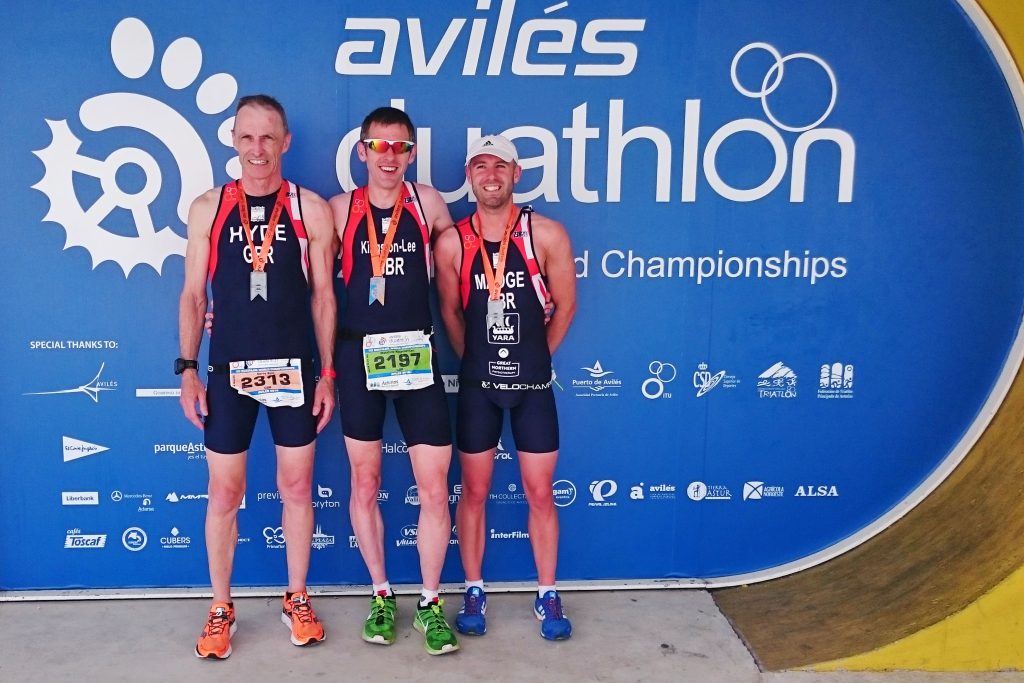If you don’t want to read all the background and preparation, you can jump straight to the race report by Clicking Here
How I Qualified For The World Duathlon Championships:
Back in early March I took part in the Dambuster Duathlon, which counted as a qualifying event for the Age Group World Duathlon Championships in Aviles, Spain. Being a total novice at the sport I didn’t hold out any hope of qualifying but, as something of a passing thought, I paid the £10 fee to allow myself to be considered for qualification.
The Dambuster is reported on elsewhere, it was by no means the best race I have ever taken part in – too many rookie errors, suffering in the cold, and struggling with sciatica. I finished ninth in my age group. I understood that only the top three qualified by right then, if you also finished within 115% of the winner’s time in your age group, you may be considered for selection on a roll down policy. I had finished around 112.9% of the winner, so satisfied that criteria, but reckoned I had finished far too lowly to ever be considered.
And so I went about running half marathons, training for the London Marathon and carrying on with the cycling, readying myself for the time trial season. Disillusioned by the way in which I was passed so effortlessly by guys on fancy time trial bikes at Rutland Water, I opted to buy a fancy time trial bike when the opportunity arose in March to purchase a local one second hand at a very good price. By no means cheap (More than double the value of my car…) but far less than to buy the equivalent new.
It sat, unridden, until at least the middle of April, the intention being to begin riding it once the London Marathon was over and done. I’d heard nothing about qualification for the World Duathlon Championships, so just over a week before the London Marathon as April came to a close, I booked my family a caravan holiday for the May / June school half term holidays.
The very next day I received an email stating something along the lines of “Congratulations Matthew, you have been selected to represent Great Britain for the 2016 Age Group World Duathlon Championships, to be held in Aviles, Spain, on Sunday June 5th!” My first thought was bugger, what about the holiday?! I then looked at the cost of flights and accommodation, which, assuming my wife was to join me, was looking at being in excess of £1500. I quickly dismissed the idea as madness.
I then mentioned it to my wife who seemed genuinely thrilled that I had been selected to represent my country at a World Championship event. She was the voice of reason – I may not have the opportunity to do this sort of thing again, and how many people get to represent their country at a major championship event? She was, of course, right. The issue was: how were we to be able to afford this?
We had just over a week to sort out the entry for the race and, ideally book flights and accommodation. Fortunately I was able to cancel the caravan holiday without financial penalty. Fortuitously too I was unable to stay at the official Team GB accommodation nor use the official flights so I was forced to think outside the box and attempt to minimise costs, but not make the trip unbearably complicated.
Using the wonder of the internet and with an afternoon to sort everything out, I firstly booked the flights. Rather than fly locally to Asturias I opted to fly, using Easyjet, from Stanstead to Bilbao. A three hour drive away from Aviles, but 1. flights were available and 2. flights were cheaper than those to Aviles. With my wife’s parents very kindly offering to look after the kids while we were away, I opted to fly out on the Wednesday morning and return on the Monday evening. Flying out a little early would allow some decent acclimatisation and also the opportunity to enjoy a little holiday with my wife for the first time since the kids came along. Return flights £180 for the two of us.
Accommodation: As we would require a hire car I saw little need to stay on the doorstop of the event. When taking part in events in the UK I am often happy to drive for nearly two hours if necessary on the morning of a race. If I could find somewhere within half an hour then this was absolutely fine. After a little searching the choice was one of two – a hotel with stunning views or some rural apartments that were twenty minutes from Aviles along the Autovia A-8. I went for the apartments – they looked great, got super reviews on Trip Advisor and, most importantly, had a kitchen where I could cook my own food – most useful before a race. £190 for 5 nights seemed very reasonable too.
Although I wasn’t using the official flight and accommodation there was the option of having my bike shipped to and from the event using Shipmytribike. £170 for the privilege seemed a lot of money, but then I did some calculations: to ship the bike using Easyjet would be £140. I would need to hire a bike box (my soft one not being appropriate for a bike costing twice the price of my road car) that would cost around £100 (And I’d need to take the bike apart, shipmybike stated that only the front wheel would need to be removed). Moreover I’d need to hire an estate car or at least a large car, which was coming in at £70-100 more than hiring a small one. Also I’d be able to put a bag of additional luggage with the bike free of charge.
The choice was therefore straightforward – have the bike shipped. Finally the hire car was booked. All the hire car companies were fairly similarly priced. I disregarded Holiday Autos as they weren’t based at the airport and went with Budget. £70 for a small car for 5 days. Bargain!
Add to that the cost of entry £180, and £80 for the compulsory Team GB tri suit, and I was £700 poorer for the potential of representing my country. But this was well under half the price it would have been had I done things officially, so there was a slight contentedness as I went about not running very well at the London Marathon, knowing that after that effort, there would be just six weeks to prepare for Aviles.
Preparation And Training
London didn’t go to plan, but there was little opportunity to dwell on my misfortune as I had to focus on Duathlon training. I don’t have a coach to turn to so had to ask a few people some questions before concluding that, much as I’d done in preparing for the Dambuster, the most important thing is to practice running straight after being on the bike. I decided to go a little further based on how I felt at Rutland and try to practice running, then cycling, then running – as the ride following a hard run I felt was almost as hard as running straight after the bike (Which is what most people find really tough). Hardly ground breaking stuff (I’ll struggle to publish a book based on my revolutionary training methods), but it works, so why complicate matters?
Moreover, I’d had the chance to ride one or two time trials on my new steed. While there was definitely potential for good speed, I was really struggling to hold the TT tuck position for more than a minute or so – my arms and shoulders killing me. A little tip from the guy I bought the bike from was to do lots of plank exercises. So I downloaded a free plank app and went about a daily ritual of doing five different plank sets.
It normally takes me around a month to get over the effects of a marathon, so I reckoned that minimising hard run efforts would be a good idea. This was easy enough in the week following the marathon as I’d come down with a stinking cold. Sundays would remain a cycling day – when there wasn’t a Grand Prix to be spent working I would ride long with Witham Wheelers; when there was a GP, I’d get out and ride around 40 miles in TT position – either on my road bike with clip on bars or my TT bike itself.
In every plan there is a session or two that not everyone would recommend. That came 11 days after London when Ben Smith, who is aiming to run an unbelievable 401 marathons in as many consecutive days, came to Grantham. I’d committed many months earlier to take part in the run and, despite the possible folly of running 26.2 miles (nearer 27 as it turned out) I wouldn’t have missed it for the world as a group of 50 or more at times visited 19 schools to unbelievable amounts of support. It was a run I will never forget and one I’d never regret doing, even if it did leave me with a sore shin for a few days – the legacy of running a little slower than I usually do.
A few days later I was going to take part in the Grantham Sprint Triathlon, mainly as a practice in transition, but missed the entry deadline by a few hours. Instead I rode 80 miles with Witham Wheelers to Woodhall Spa in glorious sunshine and temperatures in the mid twenties. I then went on a brick 5k run, very satisfying indeed to cover it without any stress at 6:05 per mile pace.
The remainder of the month was a mix of elliptical trainer; time trials and brick runs; running to the gym, spinning, and running home again; a couple of parkruns (one with a rather stiff hangover); a couple of semi-quick runs; a long bike ride; and, aside from the Ben Smith run, not a long run in sight.
Ten days out from Aviles I was working hard on the Monaco Grand Prix and didn’t get out to run until too late to run with the club. I went on a solo off-road run which was great until I took a wrong turn on a footpath and found myself being stung to bits by nettles, long grass, and anything else that was growing in the ground. My legs didn’t take well to this, especially when trying to sleep. For the next few nights I found myself tossing and turning to around 2am, then sleeping fitfully. Not ideal preparation. I also came down with a chest infection, perhaps caused by hay fever, which meant that on Saturday I just plodded six miles rather than the planned long run and by Sunday I had to hand in my sick note and do nothing at all (except work for 15 hours without break on the Grand Prix).
Monday was a bank holiday, I’d hoped to put in a long run in the afternoon. I headed out at 3pm. Half a mile into the run I was hit by the dreaded weird cramp in my right thigh that has afflicted me sporadically for the past 18 months or so. After two miles it had spread to the left leg and I was hobbling pitifully. Luckily I was outside the Meres Leisure Centre, so I was able to sit for 40 minutes on their elliptical trainer before they closed, in an attempt to will away the lacitc. It kind of worked, I had to stop a couple of times, but was able to limp four miles home before the legs cramped up again as I approached home.
On the Tuesday – the day before flying to Spain, somewhat despondent, I bloody-mindedly attempted. at the fourth time of asking, to complete my long run. Things went swimmingly until around nine miles when the right thigh began to cramp. Given that I was six miles from home I had little choice but to ignore the discomfort and run home as well as possible – which I, thankfully, was able to do. Other than the cramp, the cough, and the lousy weather, the pace was pleasing enough for the 15 mile run.
May’s training had been, until, the final few days pretty pleasing. The final ten mile time trial saw me take nearly forty seconds off my previous best time (and be able to assume the TT position for the entirety of the ride) and there was signs in the final 5k run that there was some pace in the running legs. Still though the main doubts were whether the cramps that were becoming more common would strike again and whether the by now pretty heavy cough, would clear in time for the race.
Aviles – Pre-Race Build Up
My wife and I left for Aviles on Tuesday evening, staying close to Stanstead airport with her sister before taking off shortly after 7am for Bilbao. The flight was uneventful, the baggage arrived in its entirety, and when we collected the hire car was rather pleased to see that it was a rather snazzy red Audi A1 1.6 diesel.
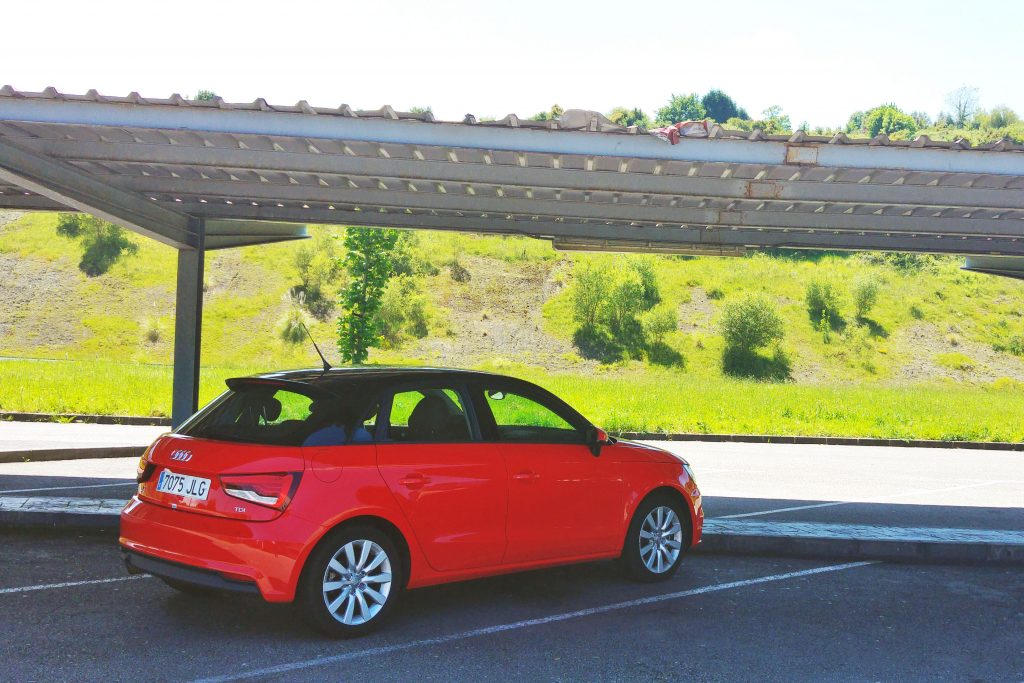
The drive from Bilbao to our apartments in Ovinana was, once the satnav had clocked that we were in Spain, rather delightful. Blue skies, no kids in the back, and the entire journey on the recently built A-8 Autovia which, for the most part, was about as busy as the M45 on a quiet day. We stopped at just after half way to tempt my wife with the delights of Tortilla de Patatas, a dish that, in my opinion, is crying out for tomato ketchup. At the airport on the way back she would get to try the mind blowing potato and egg brick in a baguette, which is €5 of tastelessness almost unparalleled.
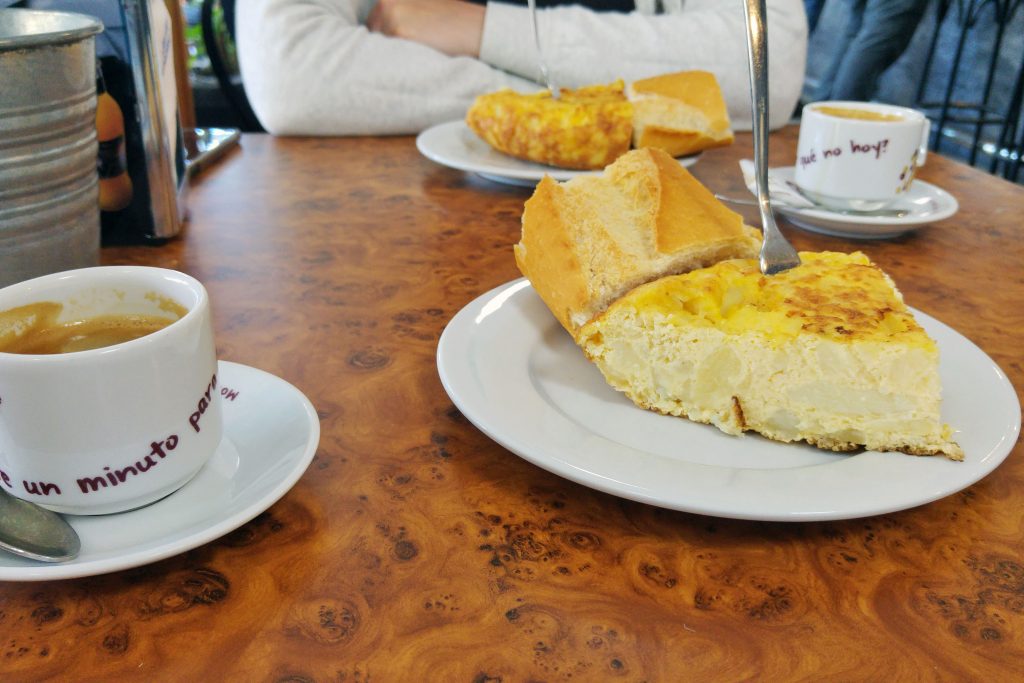
We arrived at the apartments at 3pm to locked gates and no sign of life. Not a good start. I called the number on the reservation and was told someone would be there at 4pm. Then I remembered that 2-4pm or thereabouts is siesta time in Spain. So we wandered about for a while before we were allowed into our apartment.
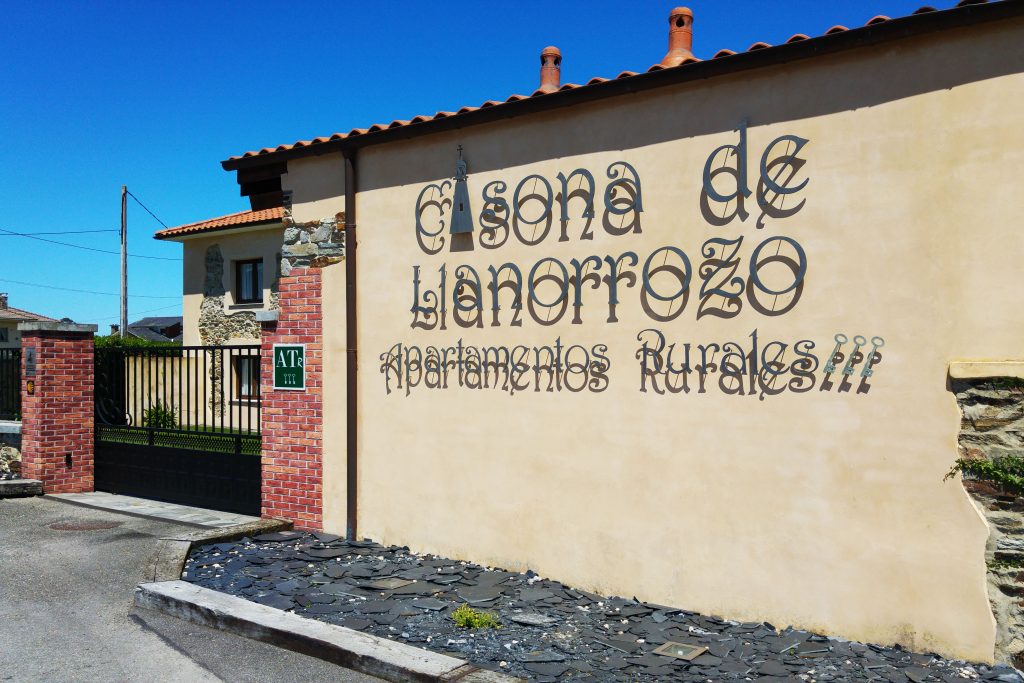
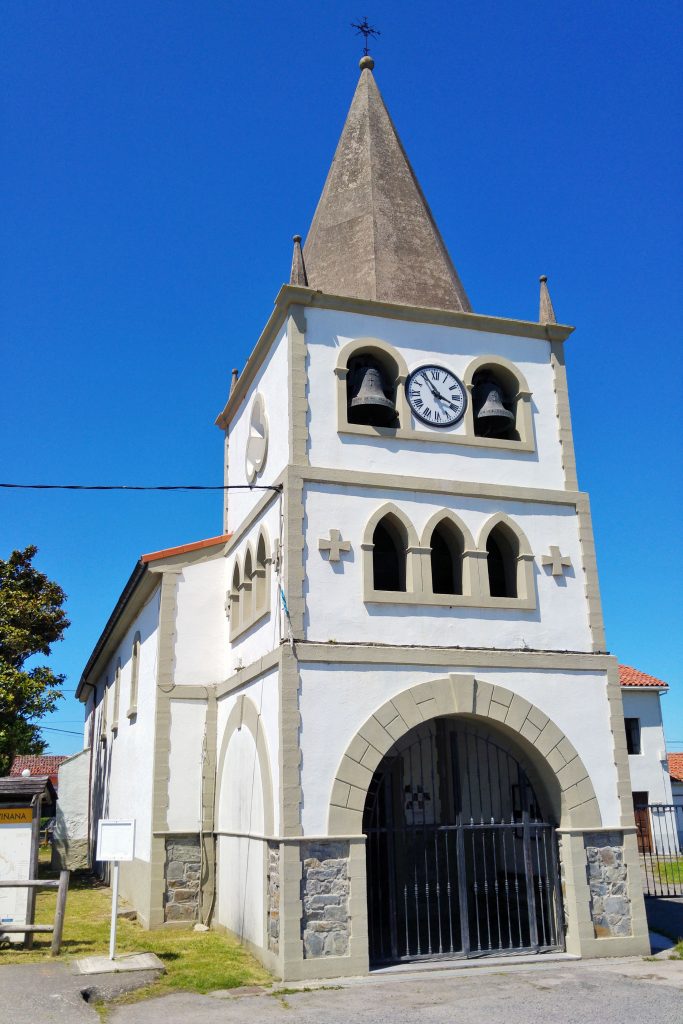
And what a great apartment it was. Immaculate. Well laid out, kitchen fully equipped, and we were greeted with a gift of a sparkling bottle of, not champagne, nor cava, but of the local speciality – cidre, or cider. I’m a big fan of cider so this was about as good an opening impression a host could ever make.
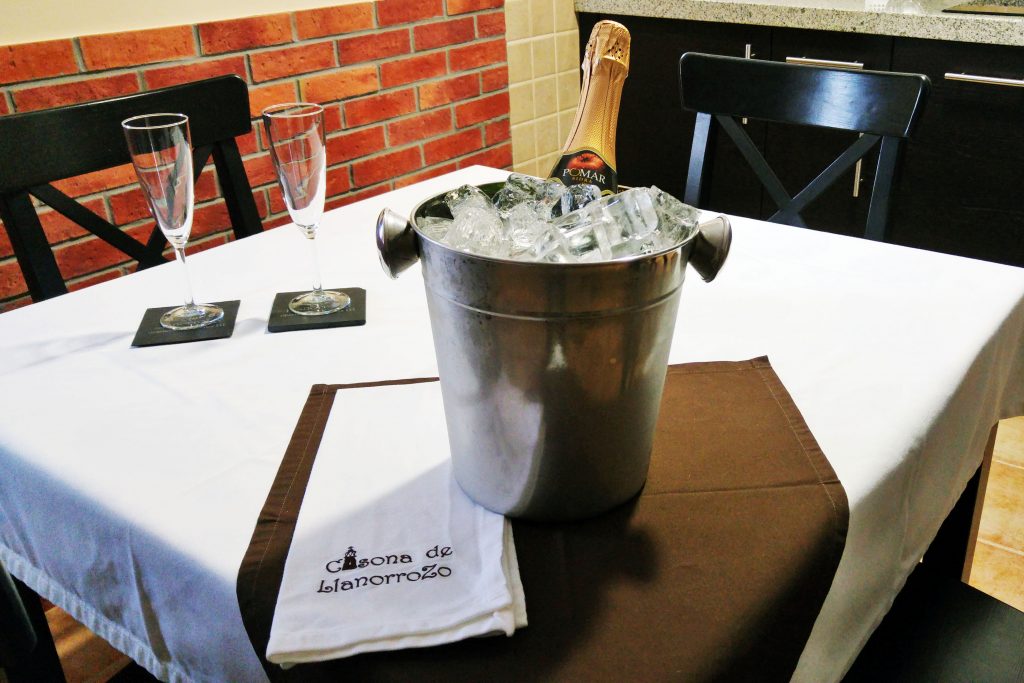
I thought about getting a little late siesta but failed, so went outside to be mesmerised by the Auto-Mower and then remembering they had free bikes. So, much to my amazement, my wife and I went on a short bike ride to the coast and back. I’ve never seen my wife ride a bike in the 22 years we’ve known each other, so this alone made my holiday. Despite initial reservations, she confessed to enjoying it ‘more than she should have’. My dream cycling holiday in the Alps may yet happen one day…
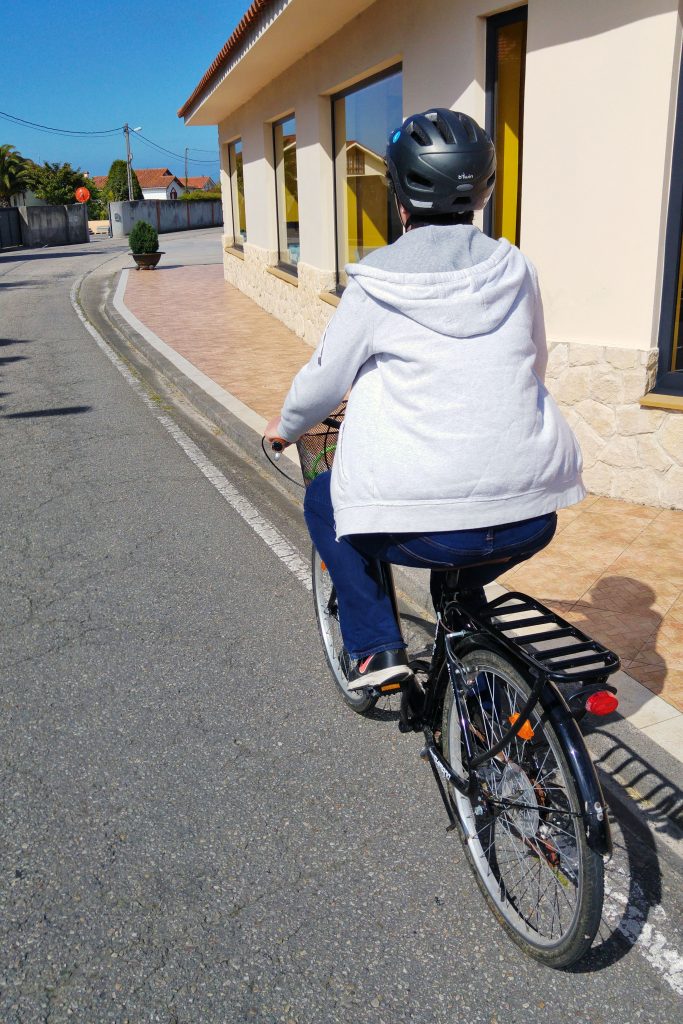
I then went for a four mile leg loosener. This involved running down a steep track to the beach, which resulted in the familiar cramp in both thighs, one though which I could run through. I had excuses this time – long journey, tiredness etc.. But three cramps in as many runs did not inspire confidence.
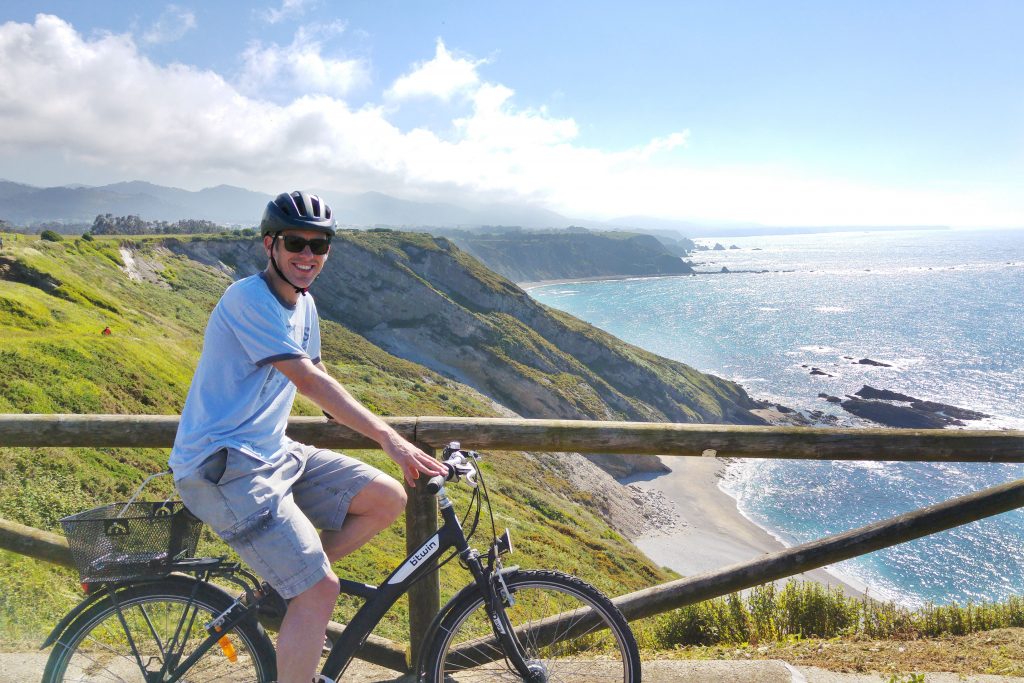
It was my intention to not get too stressed by the prospect of the World Championships and to enjoy the time away as much as possible. Where we were staying Duathlon fever had not quite hit the village so we were able to pretty much forget about the upcoming race that evening and subsequent evenings for that matter until the night before the race. Forgetting about the race entailed basically drinking a fair amount of the local cidre, the local red wine, and the local white wine!
Come Thursday morning however and there was no escaping the need to head to the Team GB hotel and begin preparations for Sunday’s race. The drive there was happily very straightforward, less than half an hour away and no traffic. The first port of call was reuniting myself with the bike that had been shipped separately. Kudos to Shipmytribike, the thing was there ready and waiting, all exactly as I had left it.
I was at the hotel to take part in a Team GB recce of the bike course. There were around 40 of us. It felt a little odd cruising along at no great speed in a group on a TT bike complete with pointy hat, but I at least wasn’t the only one in the same position. The conclusion having looked at the course was that it was fairly flat with a couple of climbs that weren’t particularly taxing, one or two technical turns and, barring a couple of tight hairpins, a pretty quick course in the making.
The quads felt distinctly tired during the ride and I took up the opportunity of seeing one of the team physios for a 20 minute massage. Within moments of assessing my cramp afflicted build up she seemed pretty shocked at how tight my quads in particular were. The prescribed medicine was plenty of massage and loads of stretching before Sunday.
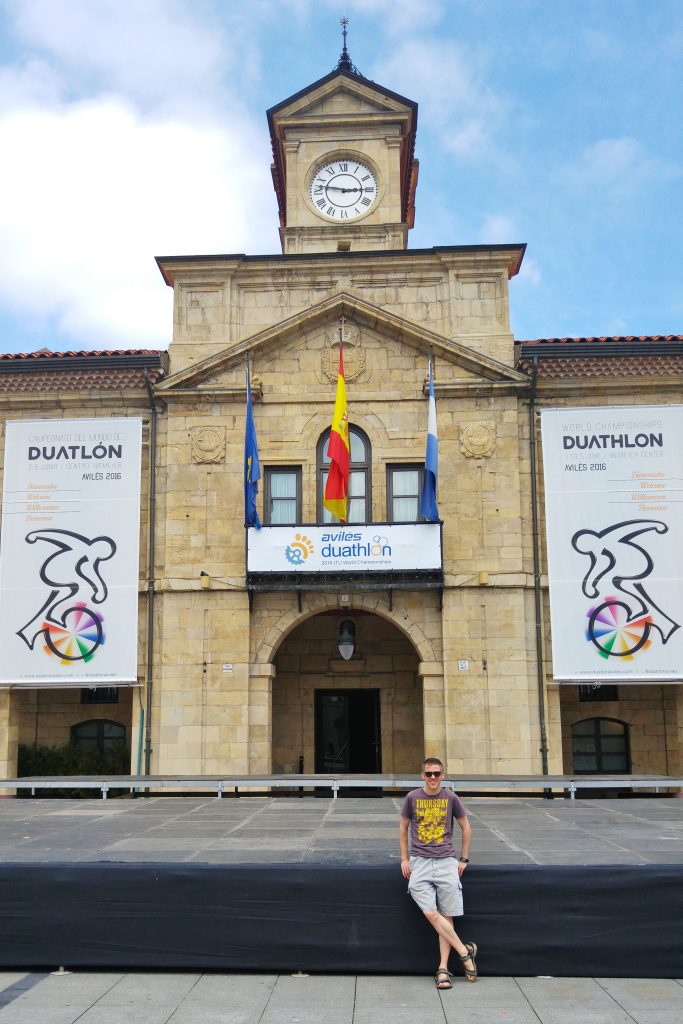
It was then time to head back into central Aviles, firstly for some lunch, then a wander around the historic and rather picturesque town center before heading to the registration area, which opened at four after the obligatory siesta.
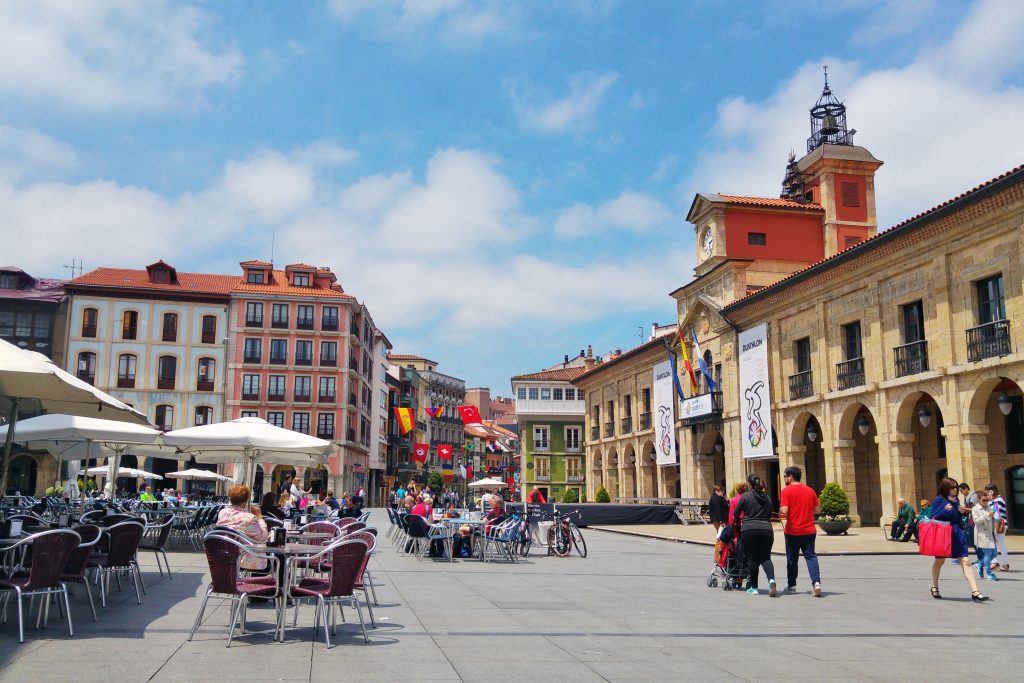
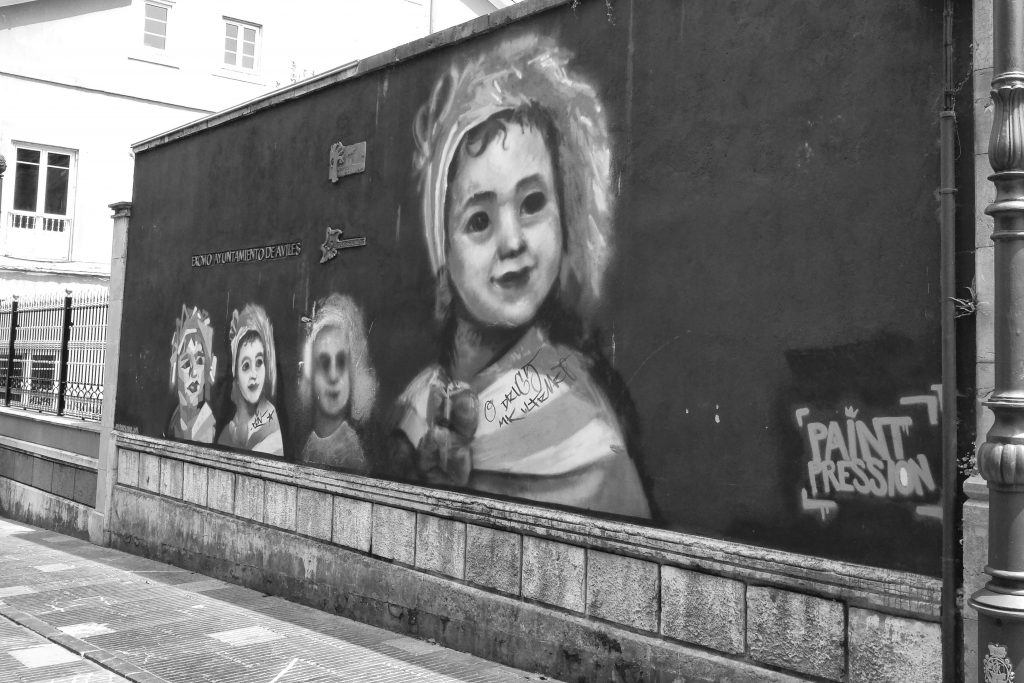
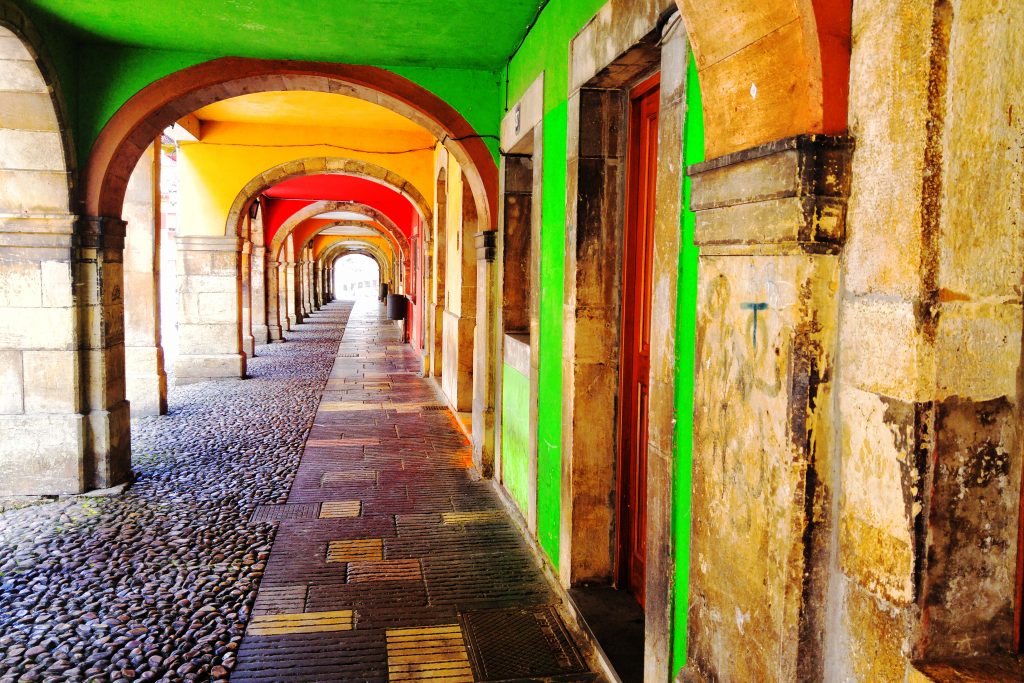
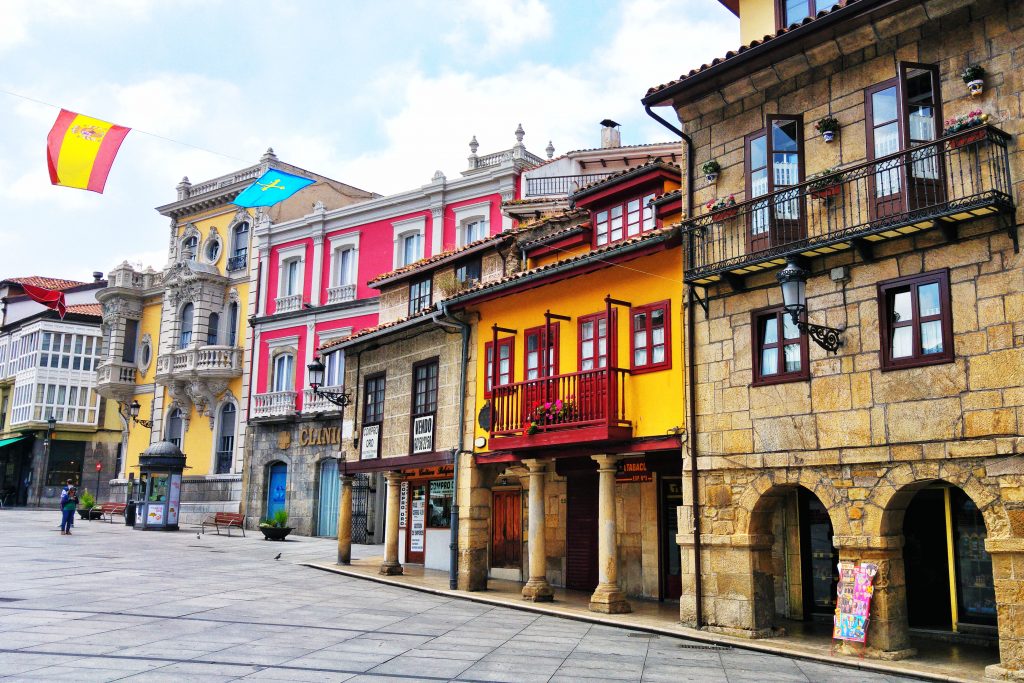
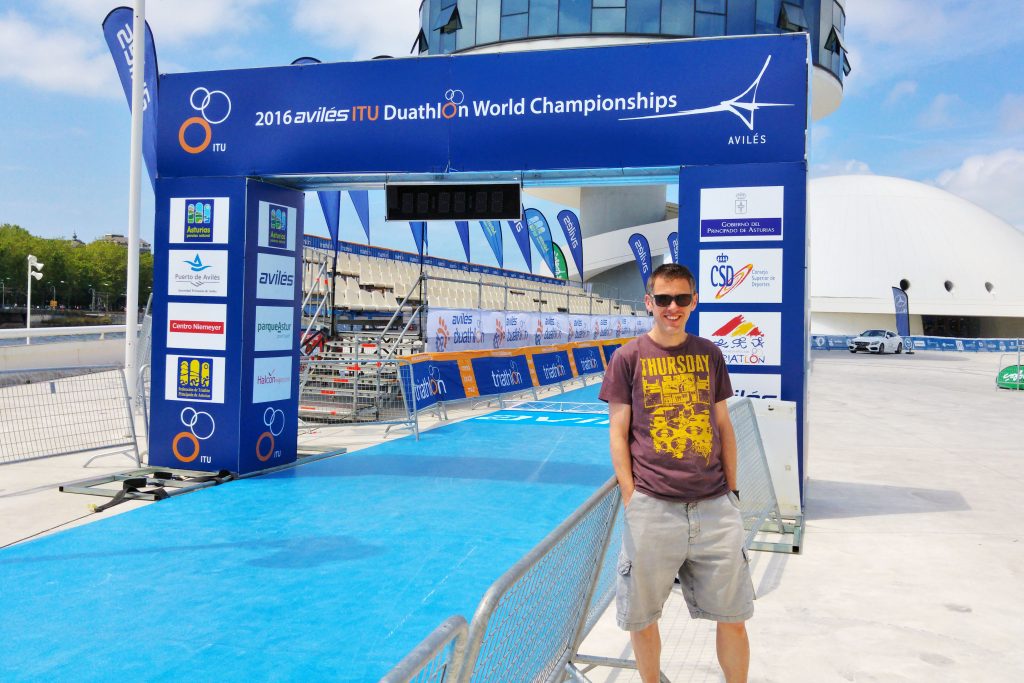
The whole procedure was a relaxed affair – I received a wrist band that wasn’t to be removed until after the race, and then in inquiring over the cost of a t-shirt, found myself bestowed with freebies! Most impressive was the official rucksack which will become my race bag of choice – festooned with pockets galore and ample storage space. Inside the rucksack was more cider and, somewhat bizarrely, what turned out to be a liter of chicken broth. This turned out to be an inspired free gift, for while many of my team mates took to dumping their broth at the hotel, I used it to make a rather delicious risotto that evening!
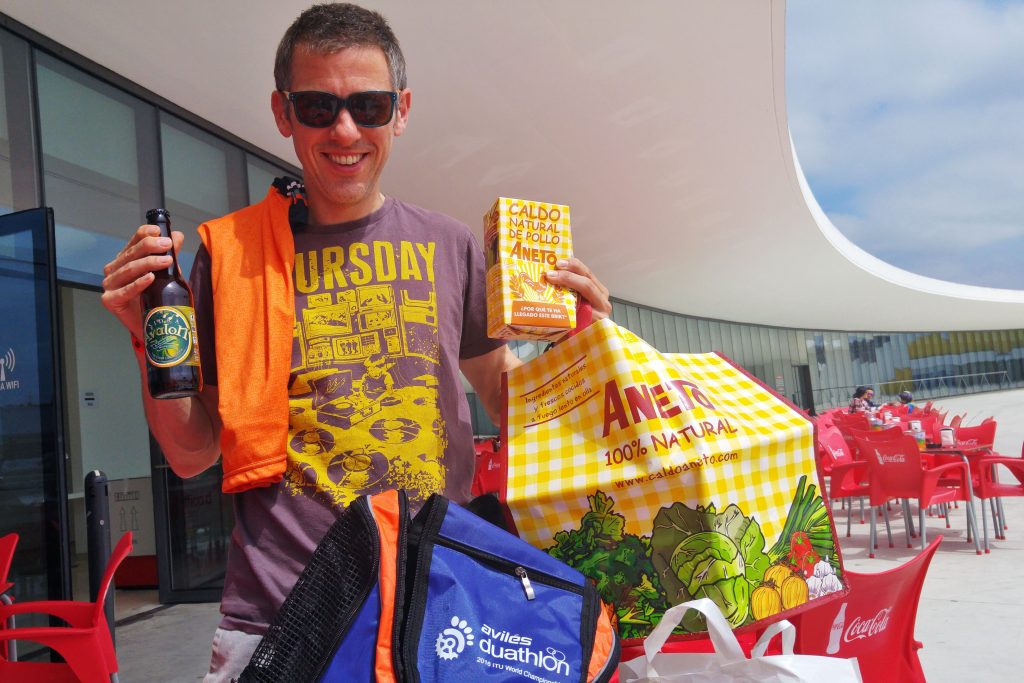
Having spent far too much of Thursday with Duathlon related affairs, I was keen to make Friday a day devoid of any contact with the event. I’d spent though a good part of Thursday evening stretching and massaging, so was keen to test the legs on the Friday morning.
In another of my not from the traditional taper text book exercises, I headed to the hills that surrounded us on the other side of the motorway. I had originally planned to just run 10k or so, but was enjoying so much a continuous 7km climb on an immaculately kept, but totally empty road, which bizarrely led to a single path gravel track, by the time I’d got back to the apartment, I’d run ten and a half miles and climbed over 1000 ft. Happily though there wasn’t a sniff of the dreaded cramp in the legs. This confidence booster I reckoned was worth far more than any possible physical tiredness resulting from the run.
The rest of the day was relaxed – a short trip to a couple of beaches and then to the very pretty fishing town Cudillero. More exciting than all the fish themed restaurants was the small pizzeria that ensured I could have my traditional pre-race meal. Friday night was spent still enjoying the local beverages, still stretching and more massaging. There was the option of heading back to Aviles to take part in the opening ceremony but I declined the offer – the thought of potentially spending several hours late into the evening on my feet didn’t seem a sensible prospect.
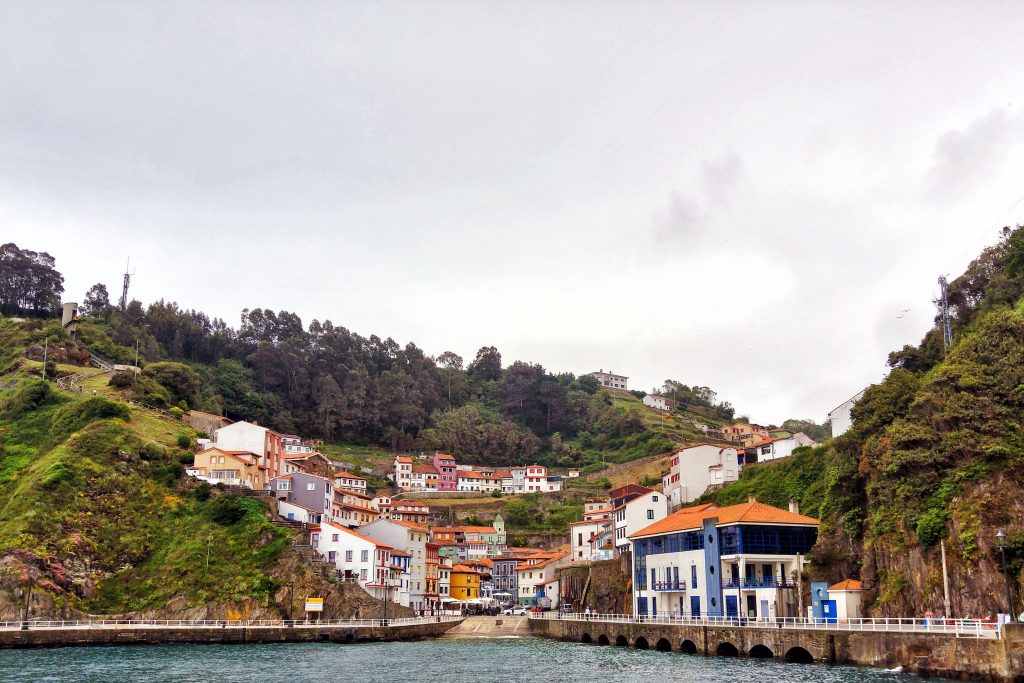
Come Saturday morning the legs felt really good, the chesty cough was still there but getting better by the hour. We had to head back to the Team GB hotel for a day of duathlon themed events. First off was the Team GB briefing, which was impressive by the sheer volume of Brits taking part in the sprint and standard distance events (Enough to fill a moderately sized hall). The event had some useful information, some less useful questions, including one from yours truly ‘What language do the officials speak?’ (To be fair this was a dare between me and my wife to try and ask the silliest question) and some motivational speeches by competing athletes, including one by Lee Piercy, who explained he was a former Age Group duathlete who turned pro at one point and was a multiple World Champion.
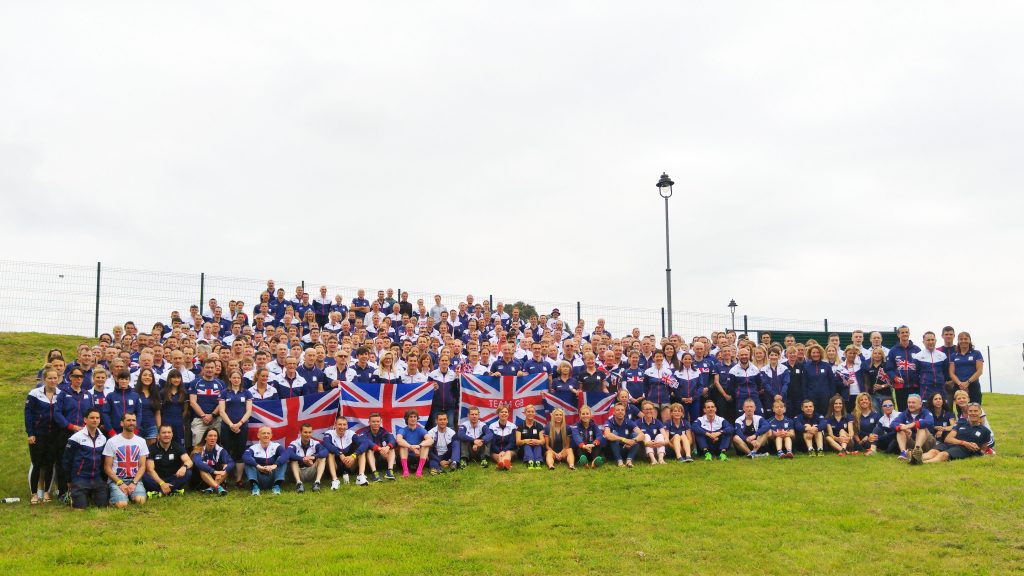
Any wild fantasies of securing gold in my Age Group were scuppered when we gathered for the customary group photos, where I found myself standing alongside my fellow 40-44 year olds by the aforementioned Mr Piercy. He still looked every inch the pro he once was, the gold medal looked almost to be hanging already around his neck.
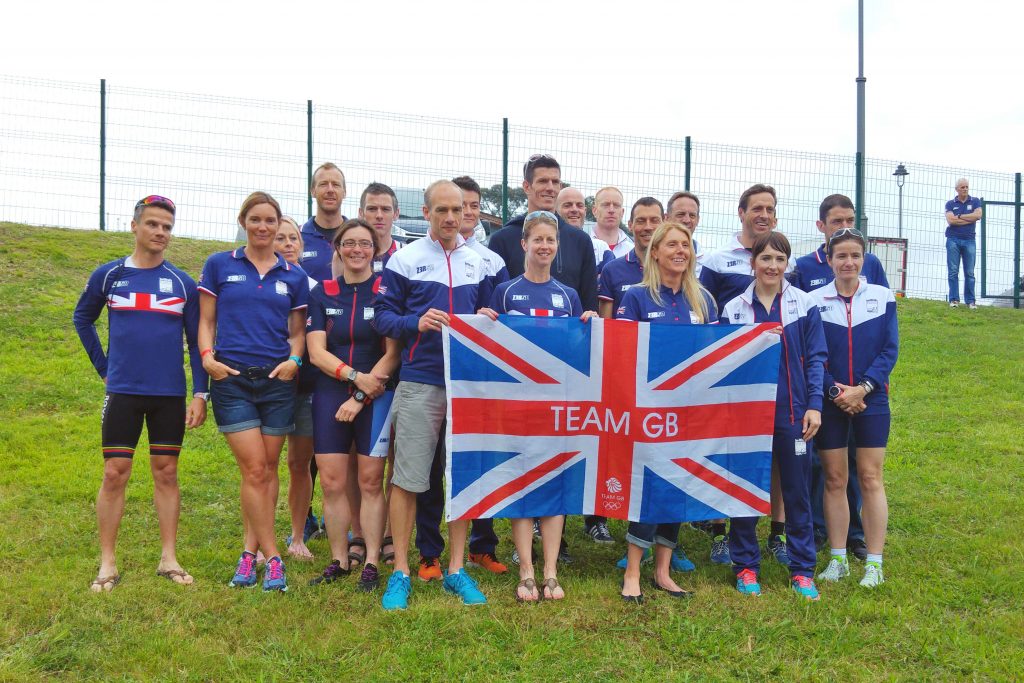
Once the photos were taken there was some time to kill before we could take our bikes to transition to be racked for the race. Rather than sit around in the hotel we headed back to Carrefour for some more food shopping and to buy some gifts for the kids. Then it was a short cycle ride to transition before some very British patient queuing as bikes and helmets were checked before we were allowed to rack up.
Unlike a triathlon there isn’t really a lot of gear left at transition – a bike, a helmet, a second pair of trainers if you are really keen (I’m not), bike shoes, possibly some bike gloves, and that should really be about it. Ultimately due to the threat of rain I left just the bike there, assured that we would be allowed into transition the following morning despite what one or two officials were saying. I then pfaffed around with the rest of the competitors, taking pictures to ascertain exactly where the bike was among all the other bikes. This caught me out badly at Rutland where I was left running around in circles trying to find my bike. I was determined not to make that mistake again. I decided to use the markings of a boat moored as a reference point as many others were doing. We joked how funny it would be if that boat wasn’t there in the morning…
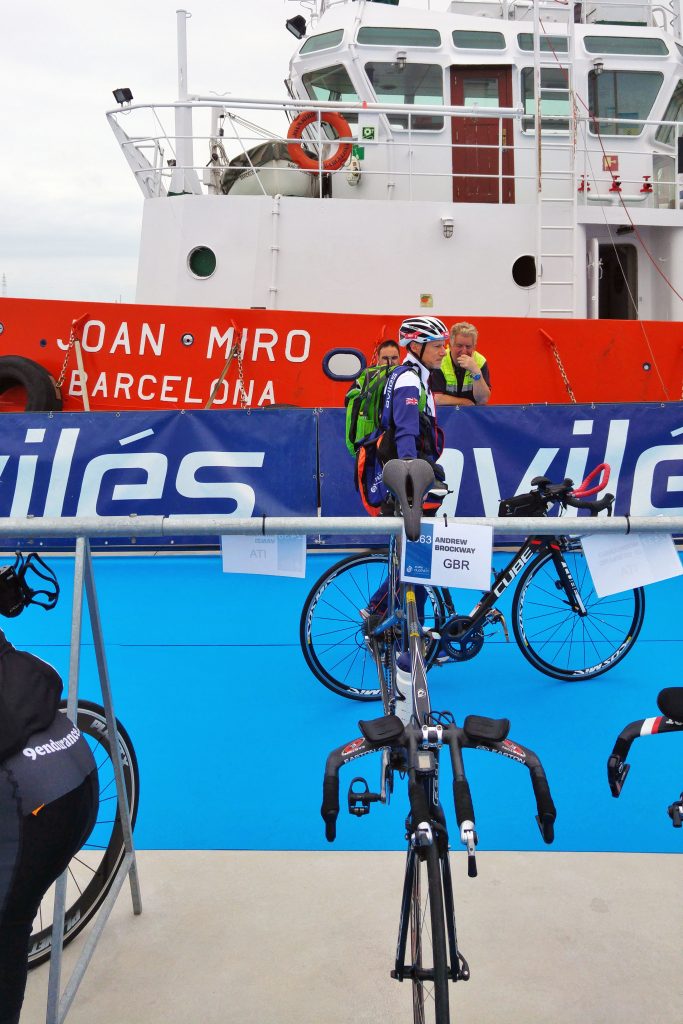
With the bike on the rack there was no more that could be done. We headed back to the hotel on the Team GB coach and headed back to our apartment. We were soon off again for my pre-race pizza, which wasn’t the best I’ve ever had but certainly did the job. We took a slow walk back along the harbour front before heading back and slowly to bed, missing the cidre, the white wine, and the red wine, but thankful I was able to get to sleep relatively quickly.
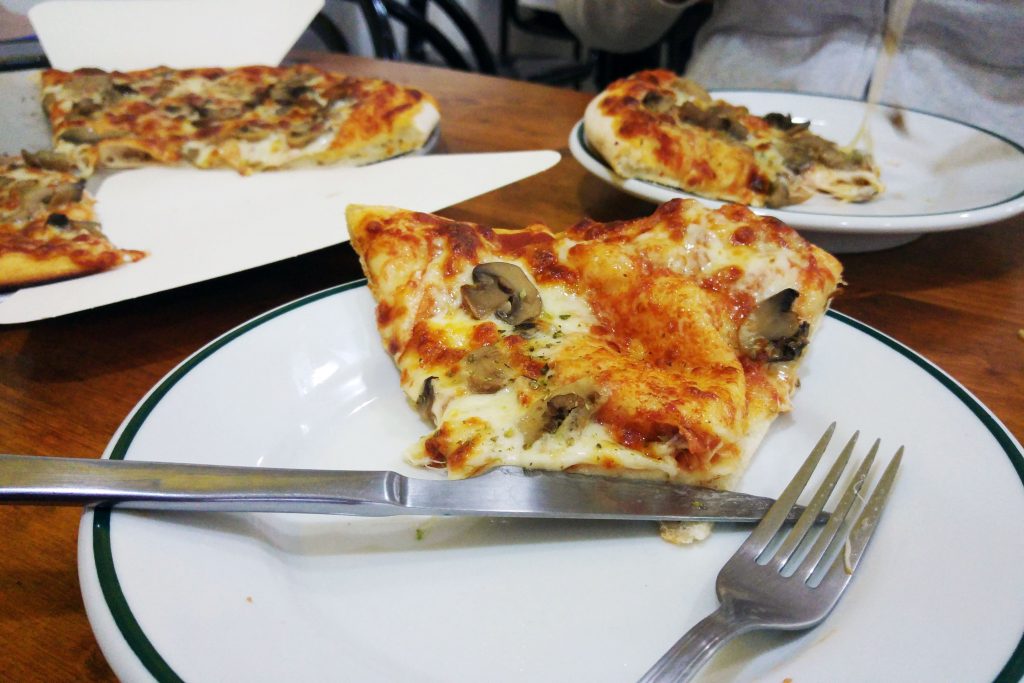
Race Day
I woke at 7 am, showered, changed into my tri-suit (Which I confess to not having worn while training, simply trying it on to see if it, more or less, fitted), had coffee, and then went about consuming four of the five cereal bars that is now my traditional pre-race breakfast. I made a final check of the bag I was taking to the race and we left at shortly at around 8:15. We were at the team hotel at 8:40 and straight onto a waiting shuttle bus, which took us to the start. I headed straight to transition and found that the boat we had all used as a visual reference point was gone! I was half expecting it, I reckoned that as the numbers on the racks were pretty large and in a fairly predictable descending order, I should be able to find my spot, as long as I didn’t panic nor rush in too quick.
I also decided on the morning, despite having practiced the art (once) I would not be attaching my bike shoes to the pedals for a flying mount out of transition. I took this decision after talking with several other competitors. Basically I was less than 30 meters from the transition line, which I could cover fairly easily wearing my bike shoes. Chances were any time made up going barefoot out of transition would be lost attempting to fasten my shoes when cycling. I did though decide that I would remove my feet from the shoes before entering transition, as it was around 200 meters of running to get back to my racking station.
All in order in transition I left to prepare for the start. There was over two hours to kill so I spent a little while watching the sprint races, paying particular attention to how they entered and exited transition. I then found myself sitting at the venue cafe passively smoking plenty of fumes before nervous energy meant I killed time by visiting the toilets, checking my timing chip and number, slowly getting changed and, finally, an hour before the start, I began to warm up.
There wasn’t an awful lot of room to warm up so it was little shuttles up and down around the back of the cafe. The legs felt… okay. Not amazing, a tiny twinge in the right quad, which I was sure was in my mind. What was noticeable was that the promised cloud cover was missing. The sun was out, the skies were blue, and temperatures felt like they were beginning to sky rocket. I’d already drunk the bottle of water I’d brought with me and, to my surprise, there wasn’t anywhere obvious where competitors could get hold of some. Eventually, in desperation, I managed to down a few swigs of a bottle I was fairly sure had been discarded.
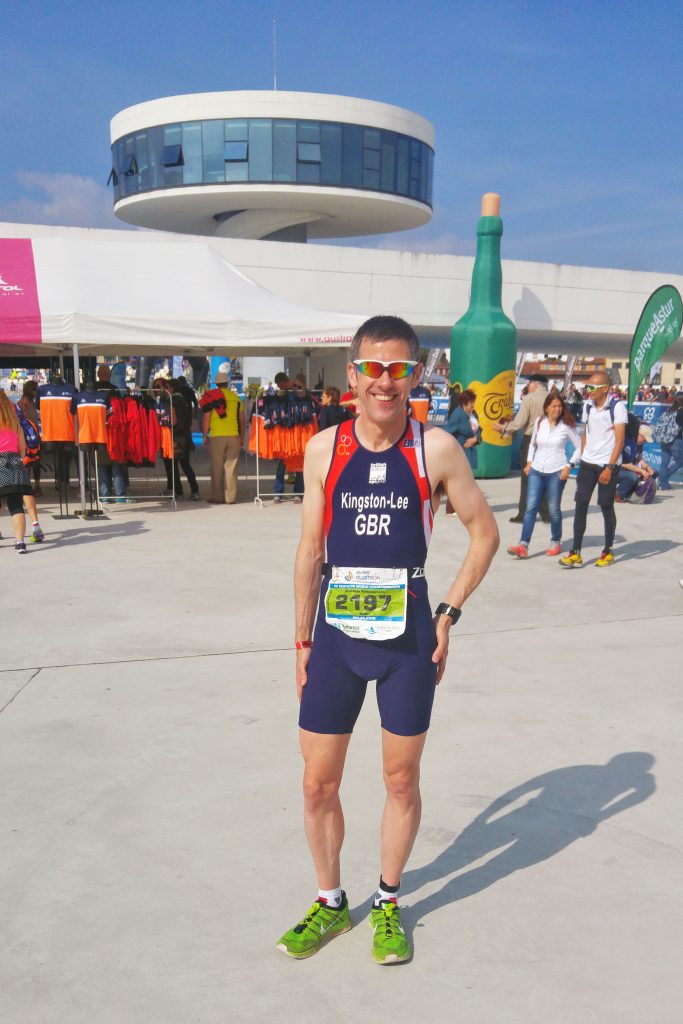
There was little else to be done except put my bag in storage, make several visits to the toilets and attempt to keep nerves to a minimum. Five minutes before the planned off at 11:25 I made my way to the start. This was it! My debut in a GB vest was about to happen!
The Age Group World Championships has competitors starting in waves based on age – youngest first. I was in the third wave covering the 40-44 and 45-49 age groups. Things were running a few minutes late but at around 11:35 we were finally called to the start line. Although I suspected I could be one of the quicker runners I placed myself nearer the back as I’d heard plenty of chatter from English speaking competitors that going off too hard and fast was a common occurrence in Duathlons.
After a long minute countdown we were called to our marks and were off. The opening km was a frantic affair as we ran around the event headquarters, past the start line and off towards the footpath along the river that would form the bulk of the opening 10km run. There was at least one faller in the opening few minutes and I was mindful to allow myself plenty of space to avoid mishap.
Once onto the footpath, although quite narrow I was able to begin passing those who had, as predicted, gone off a little too quickly. My first mile was a solid 5:30, a couple of seconds slower than my 10k PB (34:10) average. I paid half an eye on the heart rate, it had risen to half marathon levels which I had hoped it would. It was warm (around 22C, rising to a maximum of 25C) but I just focused on picking off runners and tried to ignore the warmth.
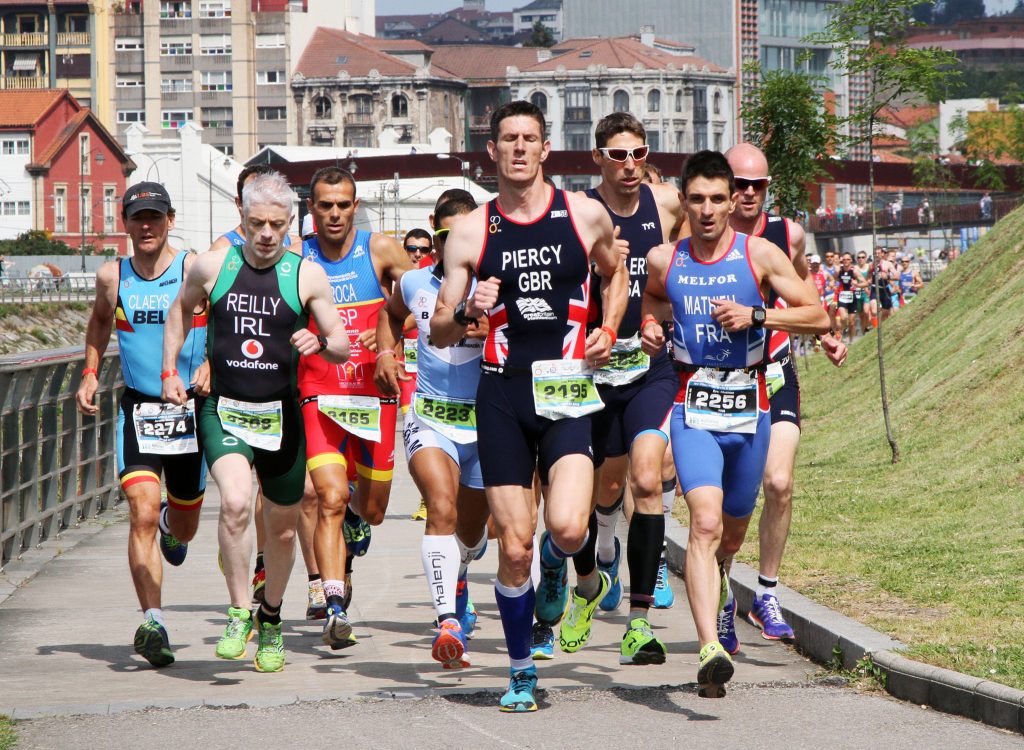
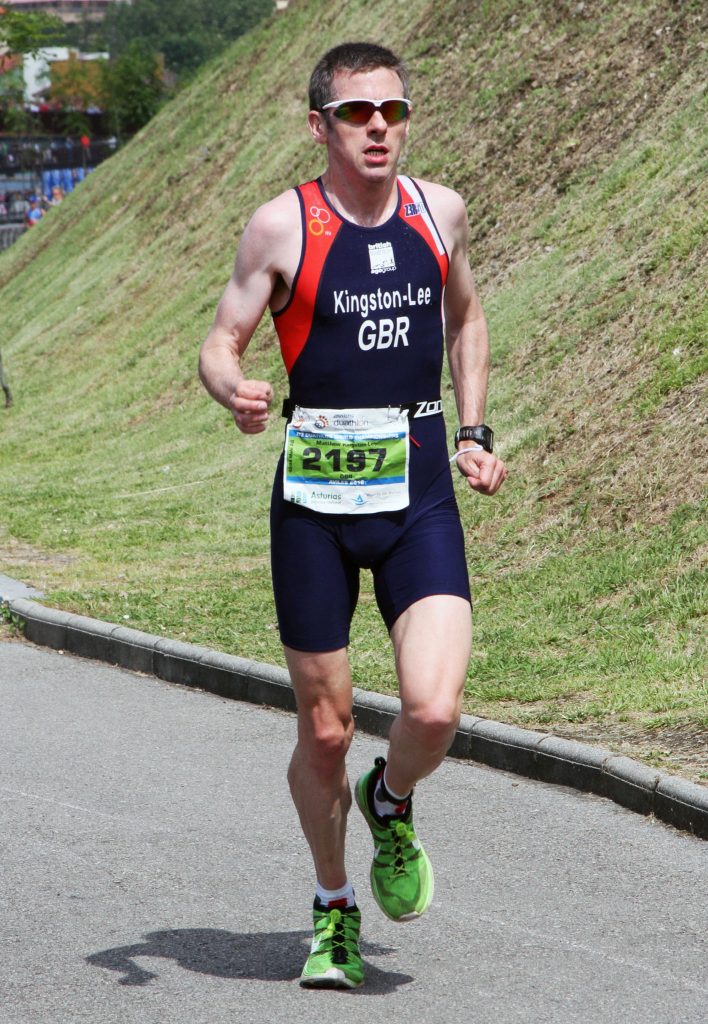
The second mile saw us head out to a bridge we crossed then headed back on the other side, albeit with a little extra loop which was extremely narrow. The second mile was slightly slower (5:35) but I was still passing runners and was by two and half miles the first runner who wasn’t in a main pack of around 10 runners. The third mile was a 5:33 and, although there were no distance markers 5k was covered in around 17:16. By now we were back at the event headquarters, running past the finish line and beginning the second lap to vociferous support from a large crowd, including many, many Brits.
I could see from my watch that the course was going to be a fair bit over 10 km so just prepared myself mentally for some extra distance. The second lap was very different from the opening lap in that we were passing numerous runners – some younger runners from earlier start pens who were running slower, some older male runners who had just begun their race and likewise some young female runners who had been sent on their way. This made it particularly tricky on some pretty narrow paths navigating my way through the field and impossible to determine what position I was in the race.
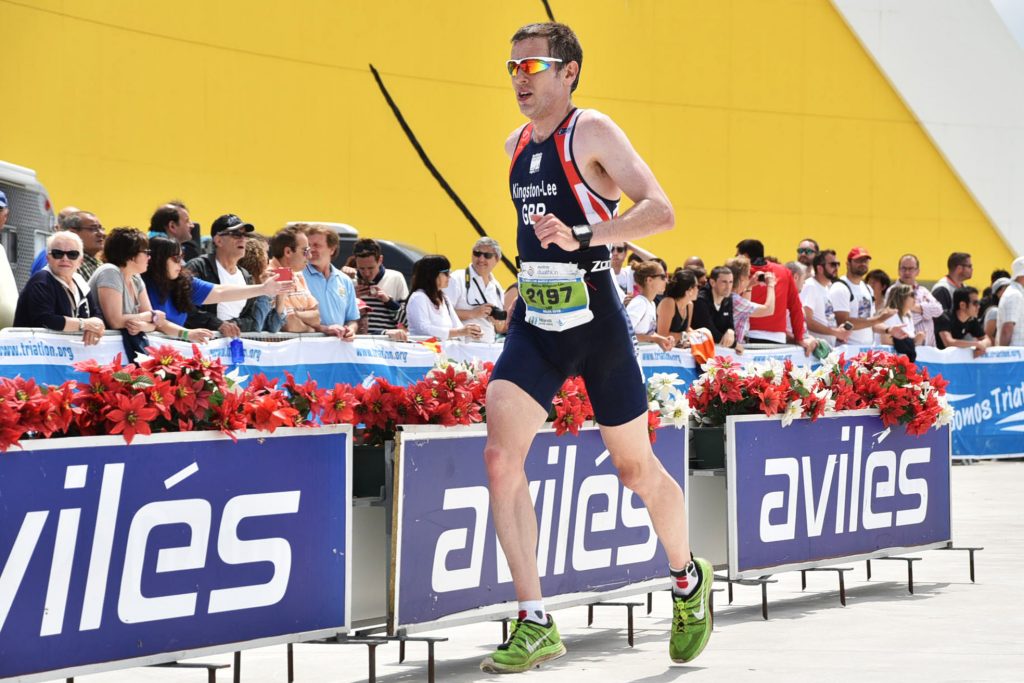
Despite the travails the mile splits rattled off with satisfying monotony, albeit a touch slower than the opening 5k: 5:38, 5:39, and 5:37 for miles four to six. A post race check shows that I went through 10k in 34:51, which, considering the heat and the twisty nature of the course I would have been most satisfied with in a standalone 10k, let alone the first leg of a Duathlon. Post race analysis indicates the official spilit was 36:04. Lee Piercy, the ex-professional was leading with a 34:44 split. I was lying fifth after the run. At the time I had no idea I was placed so highly, actually assuming I was way outside the top ten. The only indicator I had I was doing reasonably well was I had all but caught fellow Belvoir Tri Club member Adam Madge, who had started in the wave before me.
Still, there was little sign of the transition approaching. Finally, around 350 meters after we should have entered it and with the tummy giving the first pangs of distress, we were in transition. I continued to run full gas as we ran down the middle of all the racked bikes before turning sharp right at the end and entering the lane where my bike was somewhere near the other end. I deliberately slowed to a jog, not only to better spot my bike, but to ensure the heart rate had dropped a little to minimise the risk of transition panic.
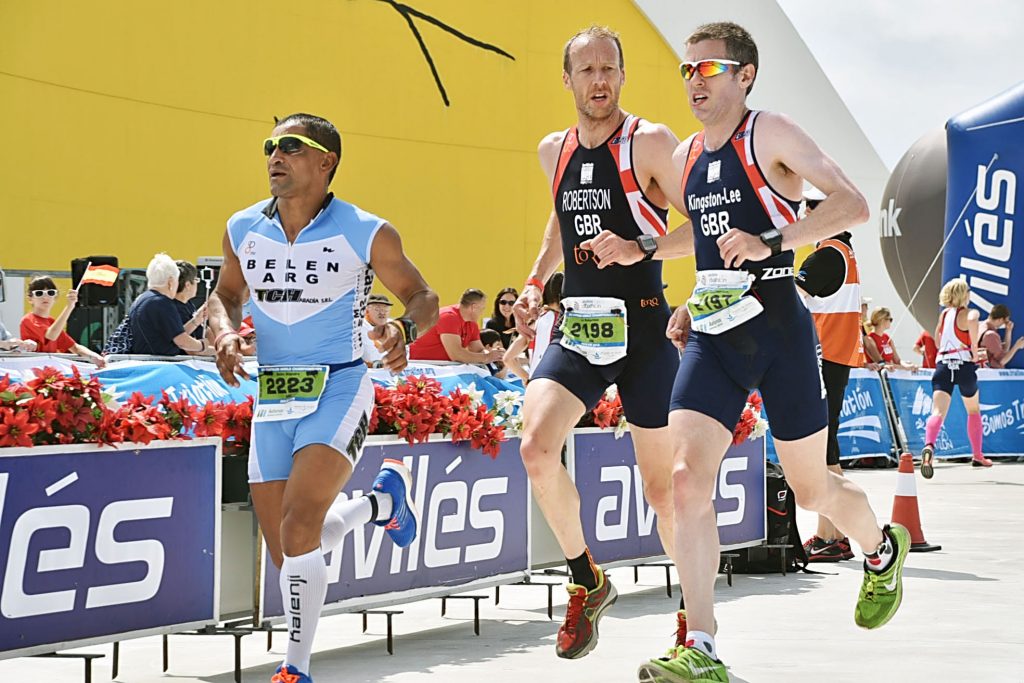
To my immense relief I found my bike. I calmly removed my shoes, placing my sunglasses in one of them as my TT helmet has a handy tinted visor attached. I put the helmet on before my bike shoes, so as not to risk touching the bike beforehand – which is an instant penalty. Thankfully I got the strap on without fuss and put the shoes on swiftly. I took the bike off the rack and made my way to transition exit. It was by no means the fastest transition – the whole process took 2:08, good enough for just 36th fastest. A fair few runners I had passed, re-passed me, but, compared to Rutland, it was a massive improvement, especially as once I had mounted onto my bike, I was straight into my cycling rather than fiddling with helmet straps, gloves and trying to fasten shoes.
Unlike at Rutland where the bike ride felt really uncomfortable on the legs from the off, here I felt much more at ease with the bike. I kept the cadence fairly low for the opening section which was flat and fast. I passed Adam. A few guys came flying past me but, as drafting is strictly not permitted, there was nothing I could do but ride my own bike leg. After a few miles of riding I allowed the cadence to increase, and as it did the heart rate came down to a level just below what I had been reaching on the ten mile time trials. I was comfortable with this as and made a point of attempting to ride as hard as possible without feeling as though I was pushing the legs too far into the red zone.
One thing I wasn’t comfortable with was the lack of ventilation on my helmet. Anticipating temperatures around 18C and cloudy to boot, I’d made the decision to keep on the plastic aeroshell which blocks the vents with the supposed benefit of making the helmet more aerodynamic. With temperatures nudging 25C and the sun beating down this was turning out to rapidly be the biggest mistake I made in the race. I had on board 750 ml of energy drink which I was rationing to some every ten minutes just as I do when on my elliptical trainer. This though was clearly not enough as I felt a rather nasty headache brewing – a clear sign of dehydration and overheating.
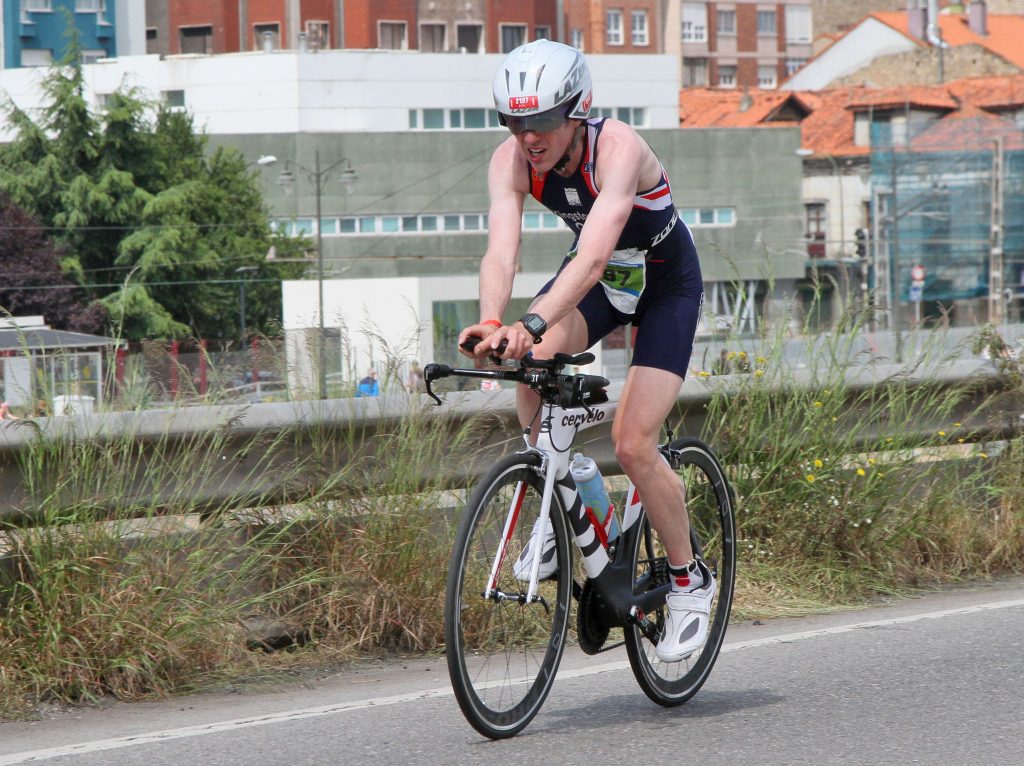
My only salvation came at a drinks station we passed twice on the far side of the circuit. They were handing out bottles of Powerade, which were a bugger to try and take of the volunteers at speed, and even harder to try and consume the contents of before the litter zone ended after around 30 seconds of cycling. On each occasion I managed to take on board around 80% of the contents – each time the tummy not thanking me for the rapid consumption of blue liquid.
Other than the helmet venting woes, the ride was fairly unspectacular. I passed plenty of cyclists, less passed me. Those who did in the latter stages drifted slowly ahead rather than blasted off into the distance. I tried my best to maintain the TT position, but used any excuse, such as a small rise or slight bend, to sit up and rest the arms and shoulders a little. I made full use of the two or three climbs on each lap to catch back up those who were a bit quicker than me on the flat, making sure though not to stress the legs too much.
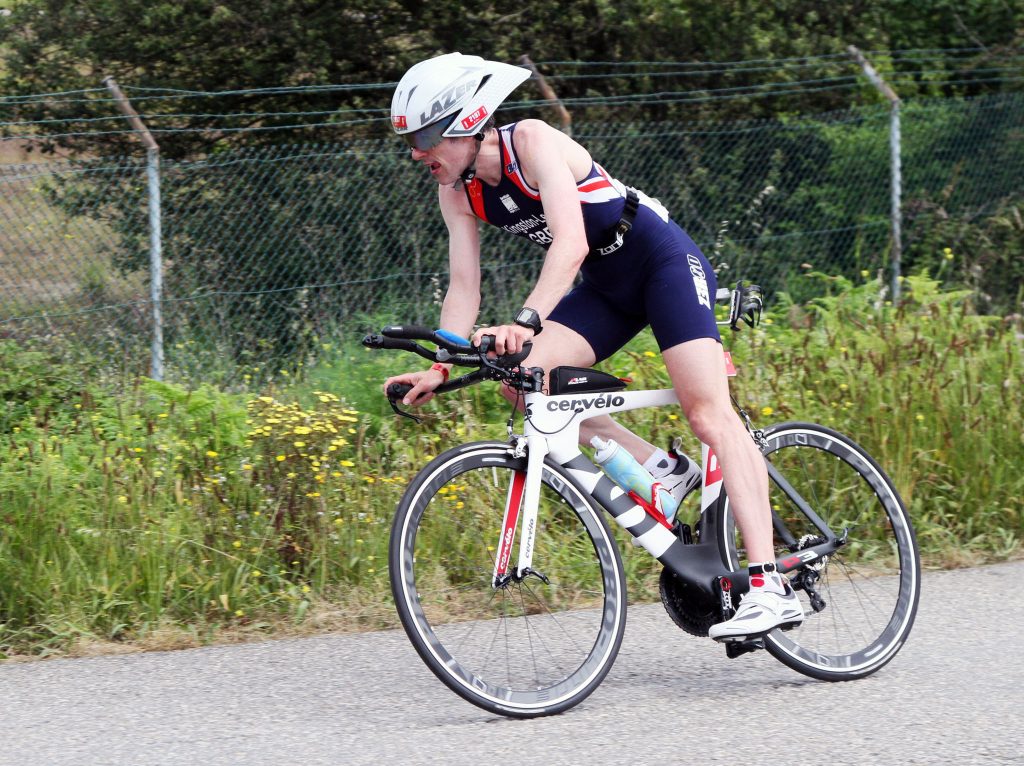
The whole issue of how many mini laps of each circuit we did was frankly a little confusing. All I knew was that, when 25 miles or so ticked over on my bike computer, it was time to peel off towards transition when instructed rather than begin another lap. The 25 miles duly arrived and so it was that I was guided off down a little access road towards transition. There was a nice length of straight tarmac to reach down and loosen my cycle shoes and remove my feet from them. I felt my left hip flexor tighten a touch but otherwise no dramas. I stopped my cycle computer as I came to a halt and climbed, drama free from my bike. My official time was 1:09:38 which was the 25th fastest time. Lee Piercy was again fastest, clocking by far the fastest time of 1:01:45. Only one other rider in my age group went below 1:06:00, meaning that a three minute or so improvement on my part would see a dramatically improved position on the bike.
Running through transition with the bike was a little tricky but I was able to find my rack position fairly easily, which is more than can be said for one poor competitor ahead of me who was frantically running back and forth desperately trying to find where where was meant to be going. I got the bike on the rack without drama, the helmet came off easily, and the sunglasses were on in a flash. I put my right trainer on and in stretching down just sensed a mini cramp in my calf. I quickly pulled my toes back to stretch the calf which dissipated any further cramping. I took more care with the left shoe to make sure there was no repeat. Seemingly seconds after arriving in transition I was back on my way. The reality was it took 2:10 (a couple of seconds slower than T1) but being the twentieth fastest transition time it was, relatively speaking, a far more successful transition.
The second run leg in a standard distance Duathlon (And longer distances I imagine) is something that has to be experienced to be properly appreciated. It is a little like the run leg in a triathlon, after swimming and cycling, but arguably harder as the legs have been weakened already by a hard run session. The nearest equivalent is perhaps imagining you are jumping straight into a road race with legs feeling like they do at around 23 miles of a marathon – that is to say they don’t generally feel very good. I set off and I got the usual sensation of the legs not feeling like they are working. They were working better than an Argentinean competitor who I had last seen at the end of the first run leg, who managed around 300 meters of running before pulling up sharply in agony with what looked like hamstring cramp.
My wife, was there near the finish line that we passed to cheer me on. She took the photo below, clearly I was still enjoying the experience more than others. The head though was still suffering the effects of not enough ventilation. Thankfully on the 2 x ‘2.5 km’ run course there were two water stations we passed twice. On each occasion I would grab a bottle of water, take a small sip, then pour the contents over the top of my head. This did wonders to cool the body.
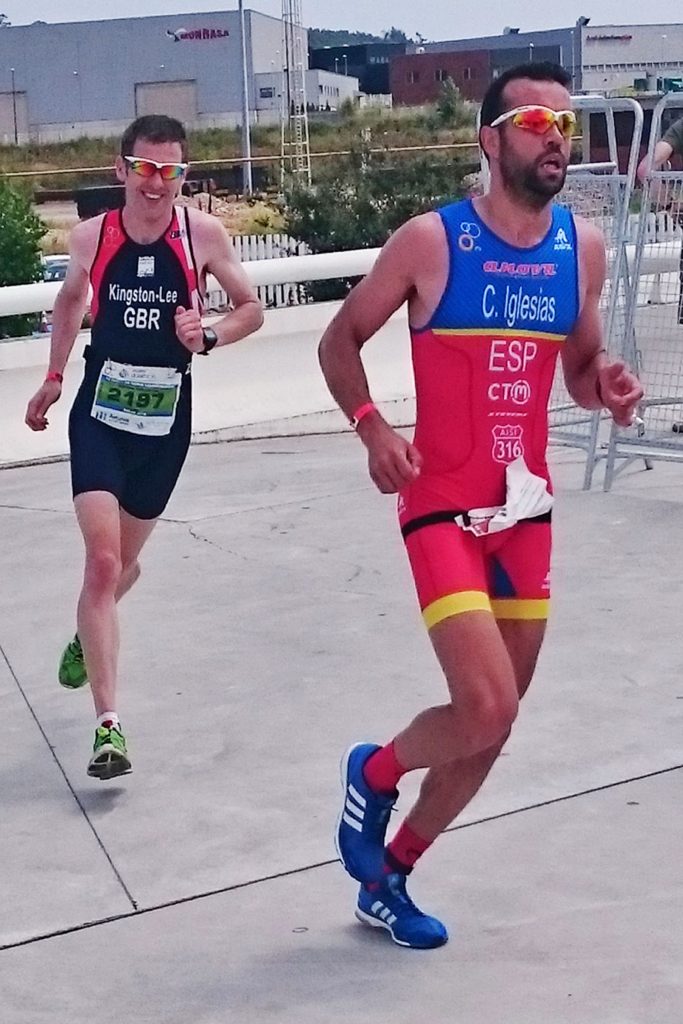
I sensed the final run could be quite good when I passed five or so runners within the first couple of minutes of running. Encouraged I continued to push as hard as I could while not wanting to risk a cramp in the calf or quads. When the mile split flashed up on my watch I was amazed: 5:35! That was quicker than my final mile in the opening 10k! It felt laboured and slow, but somehow it wasn’t.
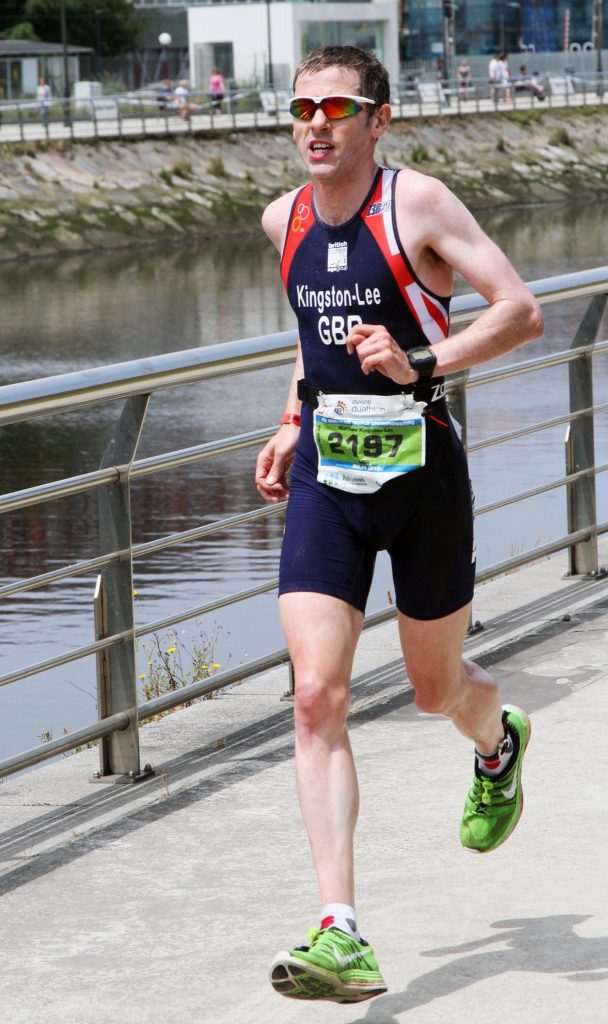
Enthused I pushed on. I looked less at my watch and more on runners ahead, seeing how many I could pick off before the finish. I had no idea if those I was passing were in my Age Group, but it didn’t really matter. I was just loving the feeling of running well and receiving the encouragement of supporters, many of them commenting on how strong I looked.
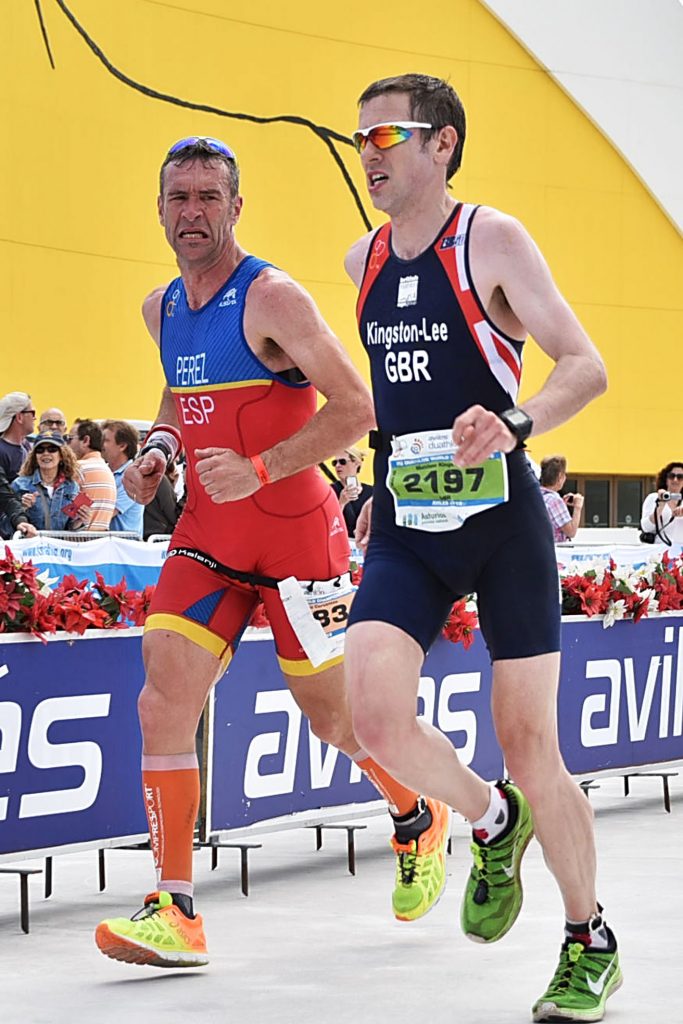
The second mile was slower: 5:40 but others around me were slowing more. I pushed on more as we rounded the top bend on the second lap and headed down the long straight for home. I began to labour a touch with half a mile or so to go, but the gauntlet laid down by a spectator of Go on! you can catch them ahead of you! proved too tempting and I put on an extra effort to catch them down, and then a couple of others before the finish.
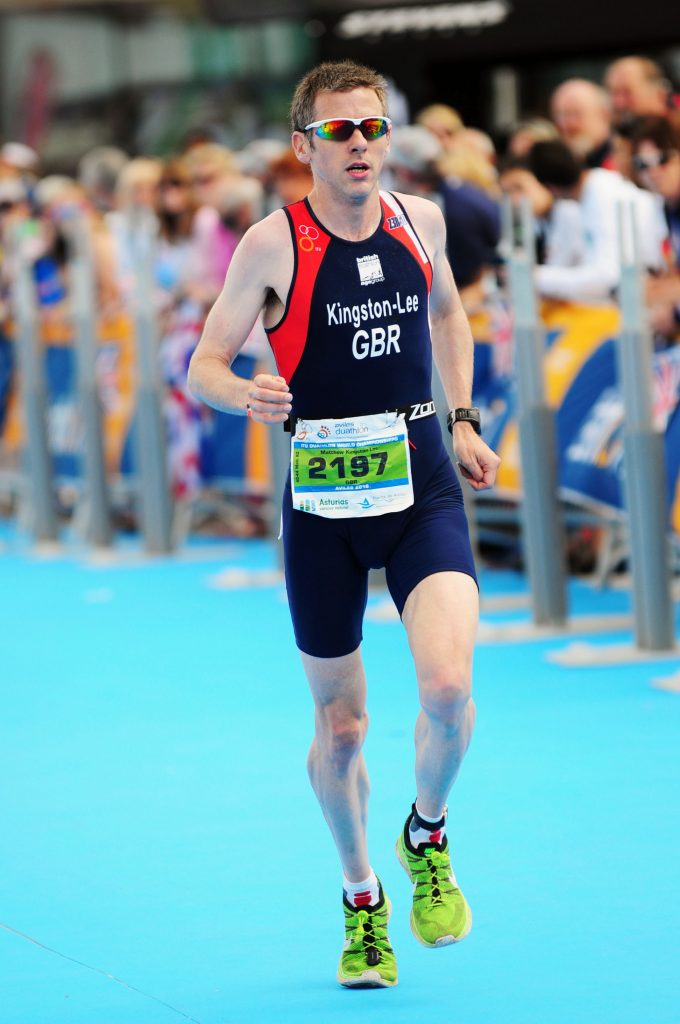
The third mile was 5:48, but there was still nearly another half mile to run, which I covered in an average of 5:35, despite numerous twists, turns, and some confusion about how to tackle the finish chute. I forgot to collect a flag at the finish, the runner in me instinctively sprinting to the line rather than lapping up the adulation of the crowd as many triathletes seem to do. I crossed the line with a little celebration, then took my customary 20 or so seconds before I felt fairly recovered. The same couldn’t be said for the Age Group winner Lee Piercy (Second overall) an unfortunate member of Team GB who was seemingly bringing back up the chocolate milkshake he had just consumed at the end of the race (Thanks to Lee for pointing out the case of mistaken identity!)
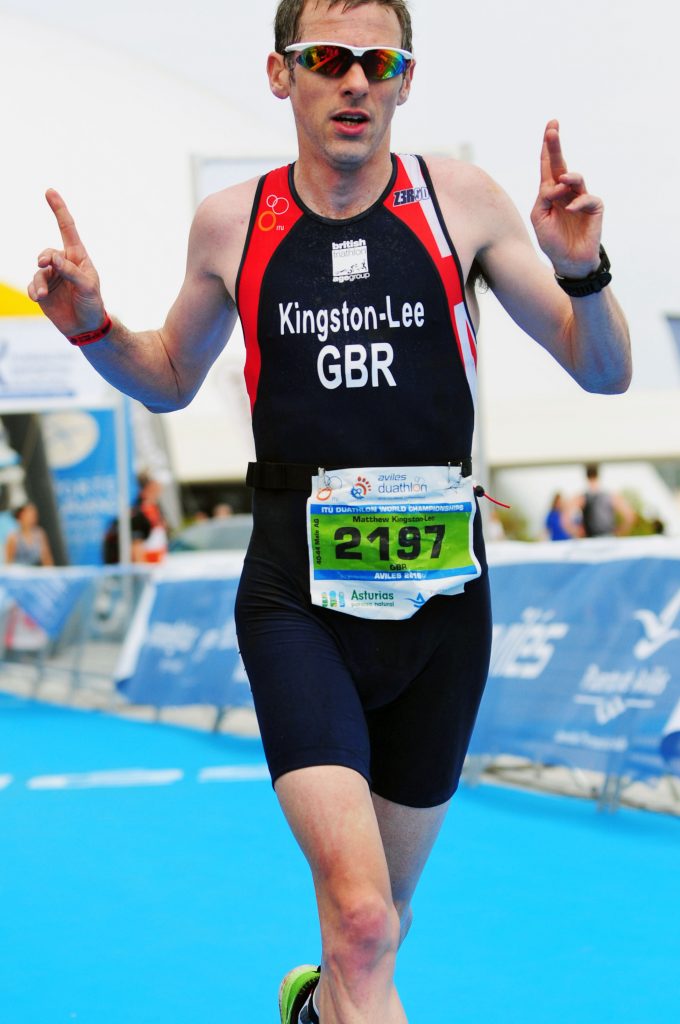
My final run split was 19:28 and it seems I tackled the 5k in 17:42. I was pleased with the run at the time. I was even happier when I got back to the apartment and was able to crunch the numbers. 19:28 was one second slower than Lee Piercy and the second fastest time in my Age Group! It was just 20 seconds slower than the clear overall winner and only one other runner in my age group broke 20 minutes (and by just one second). It seems I have a little hidden talent for being able to run after a bike ride.
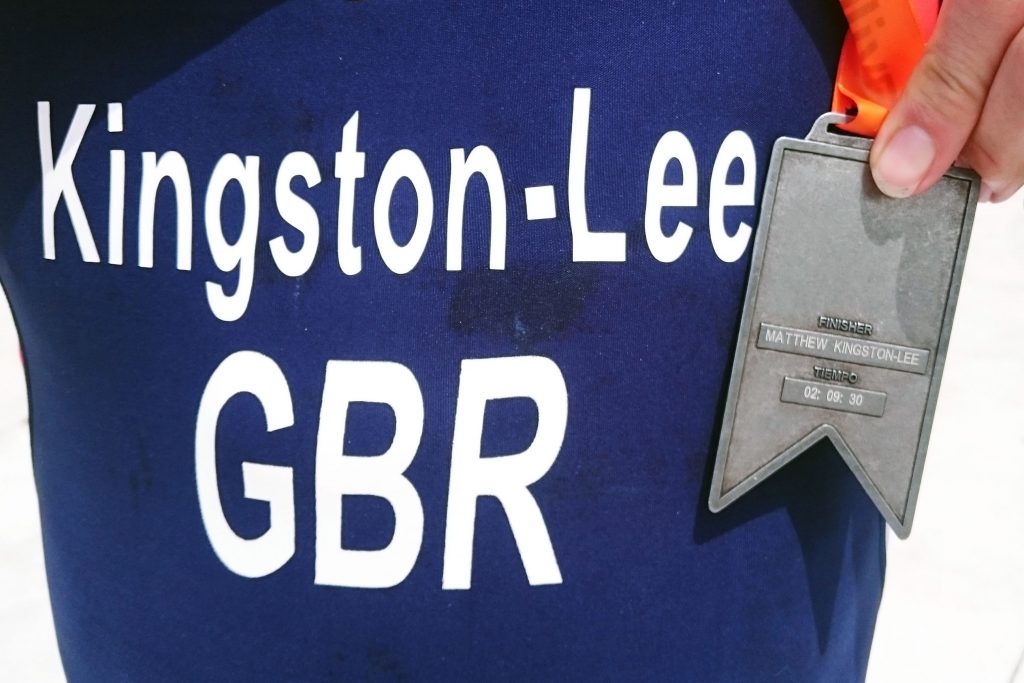
My finishing time was 2:09:30 as indicated on the engraving rapidly etched into my finishing medal. At the venue I had no idea where I had finished. At the Team GB hotel, the Aviles Duathlon phone app indicated I was tenth in my age group which I was thrilled by. Back at the apartment and looking on the website, it turned out I was seventh! I was elated! Lee Piercy had won with 1:59:26, well clear of Philip Cruise the second placed finisher. Iain Robertson was third with 2:05:37. Iain and I were well matched on the opening ten km, I was nearly two minutes faster than him on the final 5 km. It’s the three or so minutes I need to find on the bike before I can think about chasing medals. But I think that is a possibility, a dream that is attainable.
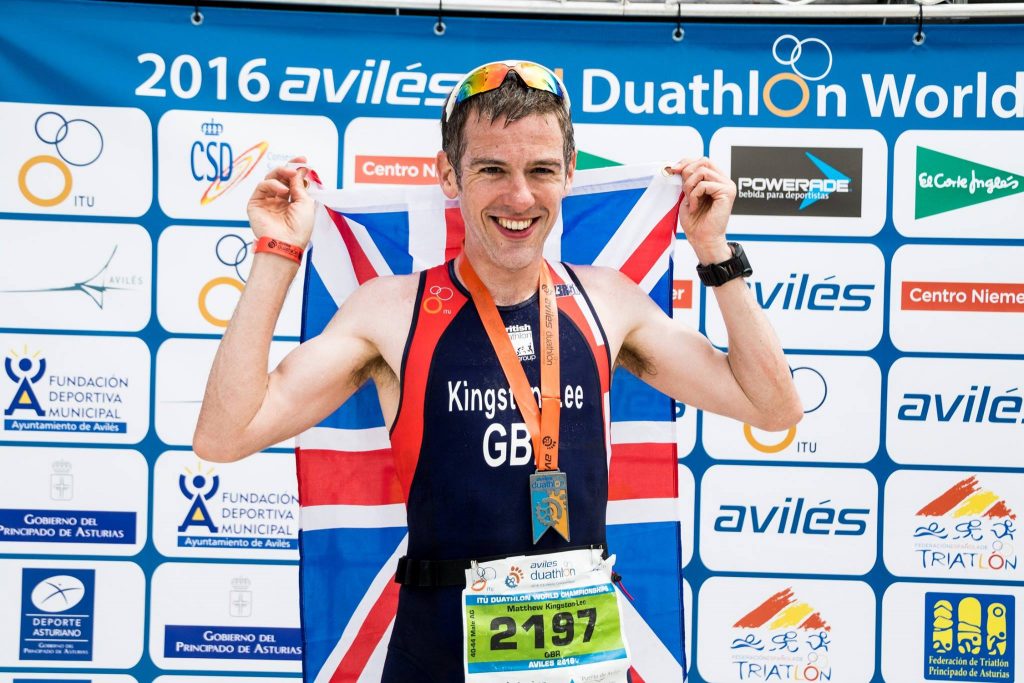
With some post race photos taken and some debriefing with fellow competitors, the World Championships came to a end. The rest of the afternoon was spent collecting the bike, heading back to the hotel (I managed to ride back, the legs feeling fairly fresh) dropping the bike with the Shipmybike guys, heading back to the apartment and drinking to my debut World Championships!
It was there I realised I had made another big mistake: I had applied factor 50 sunblock to everything except my back and shoulders. The shower was a painful experience! I later found out I wasn’t the only one to make the error. It won’t be one I’ll repeat!
It was quite an event, an amazing experience. Whether I’ll be able to attend next year’s championships in Canada is doubtful for many reasons. I’m very tempted to attempt a long distance Duathlon to see how I fair over longer runs and rides.
For now it is back to time trialing and running for the rest of the summer. The first post race run came the next morning, a delightful affair along the Spanish coastline. The first time trial the following day. Not a bad performance considering I didn’t arrive home until 3 am on the Tuesday morning. The body feels good, the mind enthused after the downer that was the London Marathon. Not many actual races planned but I look forward to what lays ahead.
